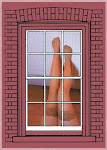
Utopía debería exportarse, como ejemplo perfecto de que el flamenco ya no es trajes de lunares y castañuelas; no los tiene, por cierto, pero sí un chelista y un percusionista. Es un espectáculo... pues eso, muy espectacular, que nace de la admiración de María Pagés por Oscar Niemeyer: los tres tubos blancos (que suben y bajan para crear un decorado distinto para cada número) son una referencia al arquitecto brasileño. La obra se estructura en torno a poemas de Baudelaire, Neruda o Benedetti, por citar a algunos.
Utopía es muy visual: desde los tres tubos, las luces y el vestuario hasta el número de los abanicos. Hace mucho ya que los músicos subieron del foso al escenario, pero la manera en que María Pagés los incorpora a las coreografías es magistral, y tambien lo fueron los números en grupo. Los solos se me hicieron un poco largos, pero sus bellos brazos y fastuosos vestidos (diseñados por la propia Pagés) conseguían embaucarme la mirada.
Utopia would be the perfect show-piece to demonstrate that flamenco has moved on from polka dots and castanets (there weren´t any, by the way. There was a cellist and a drummer).
It was a very "showy" show that was inspired by Maria Pages´s admiration for the Brazilian architect, Oscar Niemeyer (the three white tubes used as props are a clear reference to his work) and was based on poems by Benedetti, Baudelaire, Neruda to name some.
Utopia was very visual from the three tubes, the lighting, the costumes to the flashy fan number.
It´s been ages since musicians have risen from the orchestra pit onto the stage, but the way Pages incorporated them into the choreography was wonderful as were her group pieces. The solos were a bit tedious but with her beautiful arms and those lavish dresses (designed by Pages herself), well, she tricked my senses.



1 comentario:
As a musician (cellist), I would find this a very exciting performance experience.
Publicar un comentario